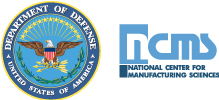052 – “Laser Ablation and Naval Maintenance Applications”
Author: NAVSEA Tactical Innovation Implementation Lab & Naval Underwater Warfare Center Keyport
Company: US Navy
Phone: (360) 507-8745
Email: janice.k.bryant@navy.mil
Surface coating inspection, removal, and reinstallation are often the critical path in ship maintenance. To modernize the Navy’s approach to surface coating removal, the NAVSEA Laser Ablation Fielding Team embraced the task of gaining approvals, delivering and employing a laser ablation coating-removal system to the upcoming aircraft carrier (USS Carl Vinson – CVN 70) maintenance availability beginning in March 2019. The Carl Vinson team’s willingness to implement Laser Ablation is the final stage of gaining approval to apply this technology directly to a major maintenance availability. This initial fielding onboard an aircraft carrier will promulgate this technology across the fleet and exponentially increase the return on investment.
The challenge of surface coating removal currently requires use of mechanical methods and extensive labor to remove the coatings. Initial estimates from the CVN 70 team projected a 70% overtime rate for their paint shop personnel for a large duration of the project given existing methods demanding an alternate solution. This endangered not only the workforce but the already constrained schedule.
To mitigate this problem, the team was tasked to identify and clear all barriers for shipboard application. Laser ablation is the process of removing material from a metal surface by irradiating it with a laser beam. The material is heated by the absorbed laser energy and evaporates, sublimates, or is converted to a plasma. Through a significant effort to challenge norms and change culture while adhering to the scientific process, the team achieved approval of a robust testing plan from all the Technical Warrant Holders after extensive collaboration across other Warfare Centers and the Penn State ARL. The test plan has been designed to provide the basis for additional applicability on other ships in the Navy inventory.
The team worked with multiple vendors to validate system availability and scalability, and leveraged relationships with the USACE Seattle District office to ensure adequacy of permit submittals across the northwest region. Additional collaboration efforts with Ogden ALC and Boeing provided the starting point for Navy standardized process instruction creation.
The team continues to ensure that that follow-on effort beyond the USS Carl Vinson will benefit other aircraft carrier and submarine maintenance as well as new ship construction. Throughout this effort, the team has provided an inclusive and effective communication methodology leveraging partnerships across the Navy to ensure ready fielding by the affected workforce, technical groups, and project.
Benefits include increased throughput of ships thereby returning more operational availability to ongoing national defense efforts, increased resource availability in a group of tradesmen that is stretched thin, improved ergonomics and safety, and a reduction in the amount of hazardous waste removal, storage, transportation and disposition.

